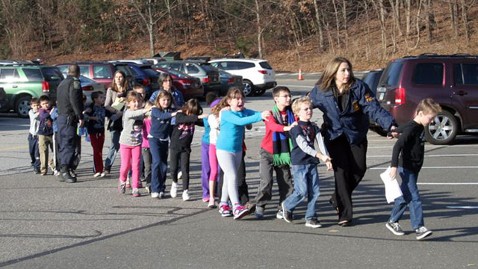Feb 11, 2013 7:30am

Credit: Shannon Hicks/The Newton Bee via AP
After tragic events involving children including the Sandy Hook Elementary School shooting the kidnapping of 5-year-old Ethan by Jimmy Lee Dykes’ in Alabama, researchers are focusing more attention on how to treat children who’ve experienced trauma to avoid post traumatic stress disorder and other psychological repercussions. But they have few answers on what course of treatment is best.
Researchers Valerie Forman-Hoffman, Dr. Adam Zolotor and the rest of their team set out in 2010 to pull together data from hundreds of studies to determine which medicines and behavioral therapy produced the best results in traumatized children and adolescents. But they were surprised to find that only 25 studies fit the criteria of being large, randomized and controlled.
“We’re seeing more and more of these [traumas] every day, but we don’t have good evidence for how to make decisions for these kids,” said Forman-Hoffman, a psychiatric epidemiologist at RTI International, a research institute in North Carolina. ”This topic is so hard to study when you consider the kids involved and what they’re exposed to. The last thing we want to do when kids are involved in a terrible tragedy and traumatic event is come in with clipboards.”
The review, which was published today in the journal of the American Academy of Pediatrics, says in its background that two thirds of children experience a traumatic event before they’re 16 years old. (This comes from a 2007 study that followed 1,420 children for up to seven years.) A traumatic event could include seeing or being the victim of domestic abuse, experiencing a natural disaster or witnessing a violent act involving strangers.
Click here to read about other abductions, starting with Katie Beers in 1991.
Although the Pediatrics review revealed that children taking medications for their trauma didn’t experience fewer signs of trauma than than those who didn’t; and that children undergoing cognitive behavioral therapy showed some benefit; it’s hard to determine how heavily to weigh the findings, Forman-Hoffman said. There were also no studies that examined treatment-outcome differences between genders, ages or types of trauma.
“It was very, very surprising to me,” she said. “This is a really important topic. Nobody seems to be talking about how to get these children who are witnesses to these things treatment.”
Forman-Hoffman and Zolotor only examined studies about non-relational trauma, meaning the the person (or thing) afflicting the trauma was not a friend or family member of the child. For instance, a non-relational trauma would be a shooting by a stranger or a national disaster, but not a domestic abuse situation.
Zolotor, a family physician and professor at the University of North Carolina School of Medicine, said he embarked on the study because he often treats patients – children and adults — who experienced trauma during their childhood. He’s not sure of the best early treatment, and added that many children don’t fit neatly into the post traumatic stress disorder diagnosis as adults do. Sometimes, they experience other symptoms of mental illness.
He, too, expected more studies and studies of better quality during the Pediatrics review. He said he hopes his findings prompt more studies to determine how to treat these children in the future.
“The science is quite immature,” he said. “With the recent experience in Newtown, I think we see this over and over again…. School of public health officials and practices feel the need to do something, and we don’t have a lot of good guidance on what’s the best thing to do.”
SHOWS: 20/20
How Should Doctors Treat Childhood Trauma?
This article
How Should Doctors Treat Childhood Trauma?
can be opened in url
http://newsdrugster.blogspot.com/2013/02/how-should-doctors-treat-childhood.html
How Should Doctors Treat Childhood Trauma?









